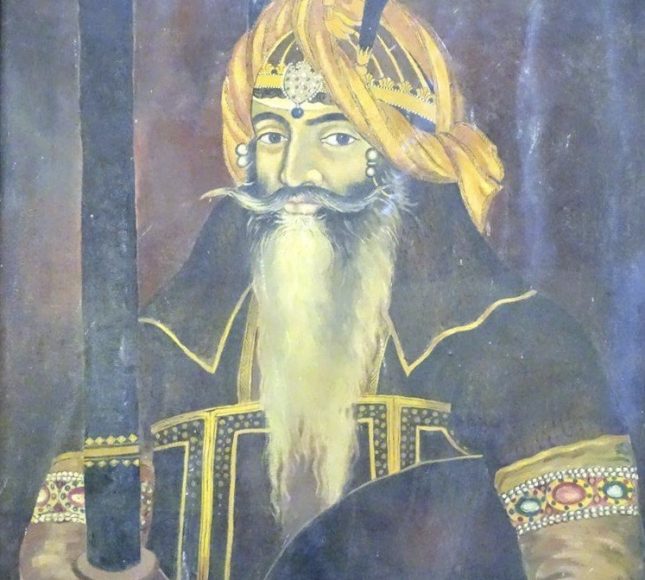JANGNAMA SARDAR HARI SINGH, by Ram Dial Anad, is a versified account, in Punjabi, of Hari Singh Nalva`s last crusade against the Afghans in which he won the field but lost his life. The poet, about whom not much biographical information is available is a Hindu (Anad) Khatri of Navan Shahar. The poem begins with an invocation to the various Hindu gods (16) and goes on to describe the Afghans` capture of Peshawar (8). Hari Singh is the only Sikh general who accepts the frontier assignment willingly and happily (10).
He moves with his troops to Peshawar via Rohtas (14), Sarai Kala, near Taxila (15), and Hazara (17). He was accompanied by Mahari Singh, Jawahar Singh, Jamit Singh Muhar and others. Hari Singh is killed fighting against the Afghans at Jamrud. Historically, it is not a very significant work as it contains no dales nor any other relevant data. However, it is a fine literary piece and provides a great deal of information about contemporary social life, rituals and customs. D.S.
JANGNAMA SARDAR HARI SINGH NALVA, attributed to Bhai Kahn Singh of Bariga, is an incomplete poem, in Punjabi, narrating the Sikh general`s successful military campaign against the Afghans (1835-37).
The only known manuscript, with some pages missing both at the beginning and at the end, was preserved in the Sikh Reference Library, Amritsar, under MS. No 5854 until 1984. Now it is available in published form in an anthology entitled Prdchm Varan te Jangndme edited by Shamsher Singh Ashok and brought out by the Shiromani Gurdwara Parbandhak Committee in 1950. Jangndmd Sarddr Han Singh Nalvd begins with the birth of Maharaja Ranjit Singh whose career is traced up to his succession to the leadership of the Sukkarchakkia misi after the death of his father, Mahari Singh, in 1792. After briefly touching upon Ranjit Singh\’s success in suppressing the feudal chiefs, the poet shifts over to the Afghan challenge in the mid thirties of the nineteenth century to the authority of the Sikh monarch.
With a view to bringing Peshawar effectively under control, the Maharaja resolved to send Hari Singh Nalva to lead the campaign to subdue the Afghans who liad invaded the territory from beyond the Khaibar Pass. The account deals with Hari Singh`s march to Peshawar, minor skirmishes with the tribals and the decisive battle against them and their ally, Dost Muhammad Khan. Hari Singh Nalva and his small contingent of men were surprised in the Fort of Jamrud by the forces of Dost Muhammad Khan. The action that ensued is narrated in vivid detail. Hari Singh Nalva falls fighting, and the poet pays full homage to his spirit of courage and heroism.1. Ashok, Shamsher Singh, Prachm Varan te Jangname. Ainrit-sar, 1950
Jangnama Sardar Hari Singh, authored by Ram Dial Anad, is a poetic account in Punjabi that vividly narrates the last campaign of Sardar Hari Singh Nalwa against the Afghans. This work captures the essence of Nalwa’s strategic brilliance and the resilience of the Sikh Khalsa forces during the defense of Jamrud, a critical frontier of the Sikh Empire.
Themes and Historical Context
The poem focuses on Hari Singh Nalwa’s heroic efforts to secure the western boundary of the Sikh Empire, particularly his defense of Jamrud against Afghan forces. It portrays the bravery and determination of Nalwa and his troops, highlighting the cultural and martial ethos of Punjab during the early 19th century. Despite winning the field, Nalwa tragically lost his life in this campaign, marking the end of an era for the Sikh Empire.
Literary Style
Ram Dial Anad’s poetic narration blends historical detail with emotional depth, creating a vivid and engaging account of the events. The verses reflect the cultural pride and resilience of the Sikh community, offering insights into their customs, values, and unwavering spirit in the face of adversity.
Legacy
The Jangnama serves as both a tribute to Hari Singh Nalwa’s leadership and a reflection on the broader struggle for sovereignty and justice that defined the Sikh Empire’s expansion. It remains a significant cultural artifact, inspiring readers with its portrayal of courage, sacrifice, and the indomitable will to resist oppression.
Jangnama Sardar Hari Singh, attributed to Bhai Kahn Singh of Bariga, is an incomplete Punjabi poem that narrates the heroic military campaigns of Sardar Hari Singh Nalwa against the Afghans during the years 1835–1837. This poetic work captures the essence of Nalwa’s strategic brilliance and the resilience of the Sikh Khalsa forces as they defended the western frontier of the Sikh Empire.
Themes and Historical Context
The poem vividly portrays the battles fought by Hari Singh Nalwa, including his efforts to secure the Khyber Pass and fortify Jamrud, which marked the western boundary of the Sikh Empire at the time of his death. It highlights the courage and determination of the Sikh soldiers under Nalwa’s command, as well as the cultural and martial ethos of Punjab during this period.
Literary Style
Written in Punjabi, the poem employs a narrative style that blends historical detail with emotional depth. It serves as both a tribute to Nalwa’s leadership and a reflection on the broader struggle for sovereignty and justice that defined the Sikh Empire’s expansion.
Legacy
Although incomplete, Jangnama Sardar Hari Singh remains a significant cultural artifact, offering insights into the socio-political dynamics of the time and celebrating the enduring spirit of the Sikh community. It continues to inspire readers with its portrayal of courage, sacrifice, and the indomitable will to resist oppression.



